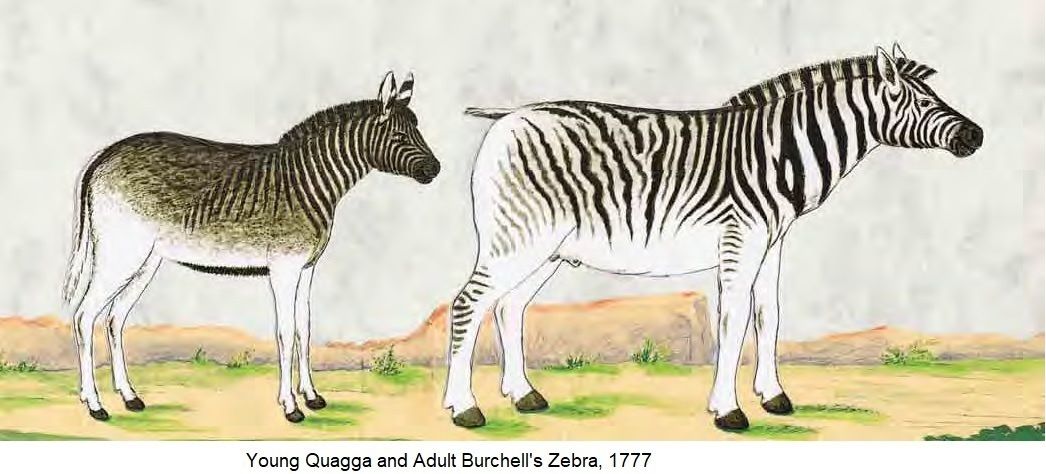
THE QUAGGA
The Quagga was a close relative of horses and zebras. It was a yellowish-brown zebra with stripes only on its head, neck and shoulders and with pale legs. The quagga was native to desert areas of the African continent until it was exterminated in the wild in the 1870s. The last captive quaggas died in Europe in the 1880's. Zoos sent the request "send more quaggas", but there were no more quaggas left alive. It had been ruthlessly hunted for meat and leather by South African farmers and settlers. When first discovered, the Quagga was simply regarded as one zebra among many and was originally considered to be the female of the Burchell Zebra as the ranges of the species overlapped and there may have been interbreeding. The Hottentots used the same name for both animals. Because the term "quagga" was used indiscriminately to mean any zebra (although "Bontequagga" was sometimes used for the Plains zebra), the true quagga was hunted to extinction without this being realised until too late.

The Quagga was basically a brown zebra with white legs and tail. It had no distinct markings on its hind quarters and only vague mottled markings on its back. In conformation it was more horse-like than any of the other zebras which, except for the Burchells, are generally large-headed and donkey-like. Its mane was distinctive, being described by an early observer as "curious, appearing as if trimmed by art". In the wild, quaggas grazed in mixed herds with wildebeest or hartebeest and ostriches.
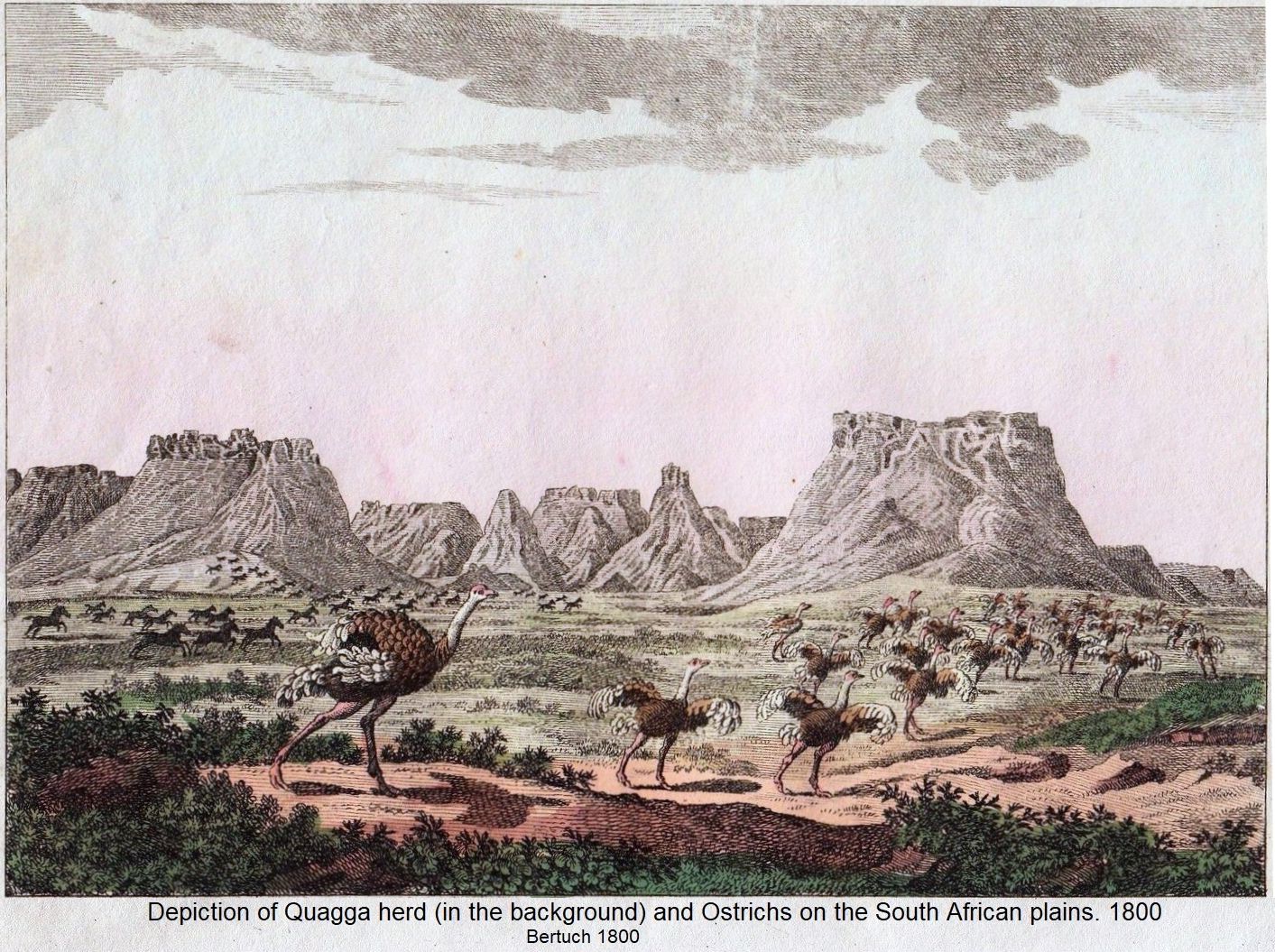
The quagga's name comes from the Hottentot term for the creature, being an imitation of the zebra's"kwa-ha-ha" call. Tame quagga were used by the Hottentot as equine watchdogs. Although tamed by Hottentots, the quagga was an immensely energetic and highly-strung creature and the stallions were noted to be prone to fits of rage. London Zoo’s one chance of breeding quaggas in the 1860s ended when the stallion beat itself to death against the wall of its enclosure. Dutch farmers in the Cape of Good Hope reportedly tried to use them as draught animals, but they proved unruly and often dangerous. In the mid-1800s transport companies in the Orange Free State, such as Zeederberg Transport Co., used mixed teams of quaggas/zebras (the 2 terms were used interchangeably) and horses to pull wagons. Zebras were tough, good pullers but they were nervous and kicked and bit too much. In England in the 1830s, quaggas (probably gelded to make them tractable, and in mixed teams with horses which are more even-tempered) were used as exotic harness animals. Sheriff Parkins drove around London seated behind a pair of harnessed quaggas. Burchell's zebras were also popular between the shafts, but quaggas were said to have better mouths.
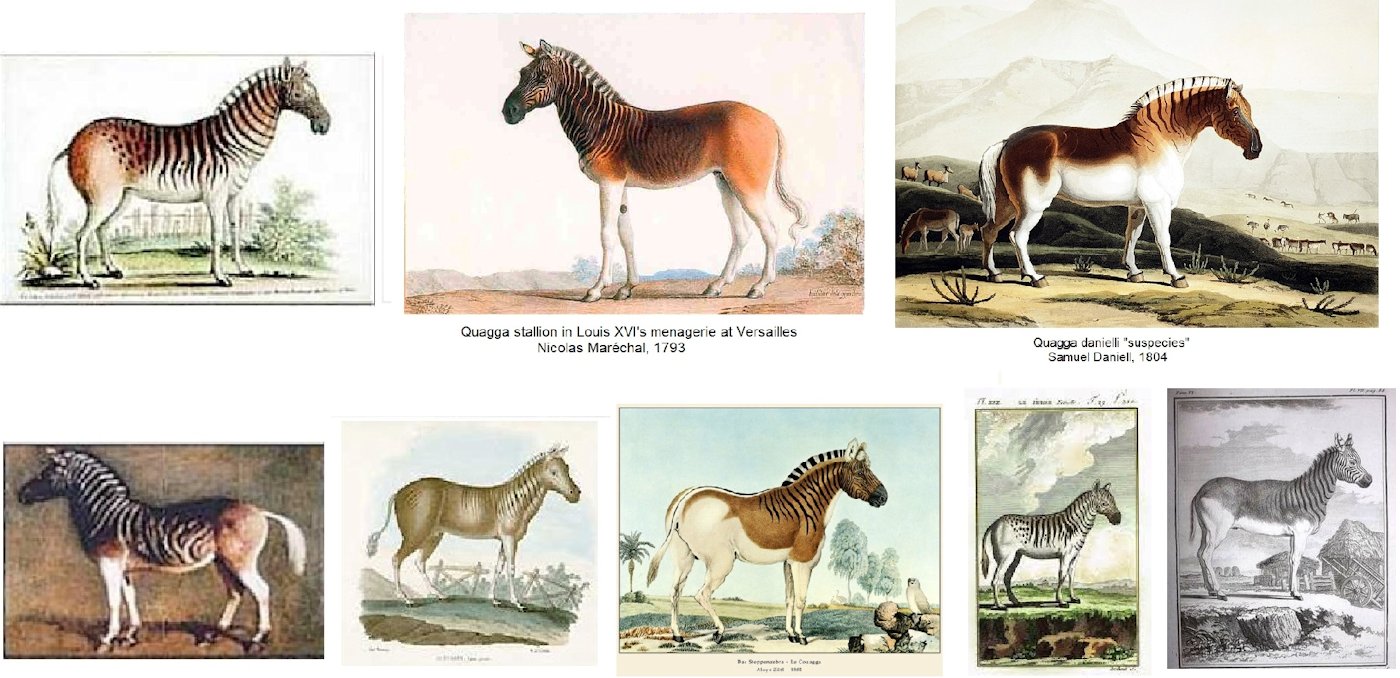
The colonizing Boers found it the most obvious source of food for their native servants and a source of hides for domestic use and export. Quaggas hides were sturdy and lightweight and many were still in everyday use long after the animal itself was extinct. Quagga were plentiful in the 1840s, but the eradication of the quagga only took around 30 years.

Photography was still in its early days and relied on the subject to make no sudden movements while the plate developed. The only living quagga photographed was the mare housed at London Zoo. She was photographed by Frederick York and Frank Haes in 1870. Four or five photographs exist and have widely reproduced. These are outnumbered by colour paintings (colour plates in naturalist's books, paintings of quaggas in private collections); the earliest paintings being based on descriptions and/or skins.
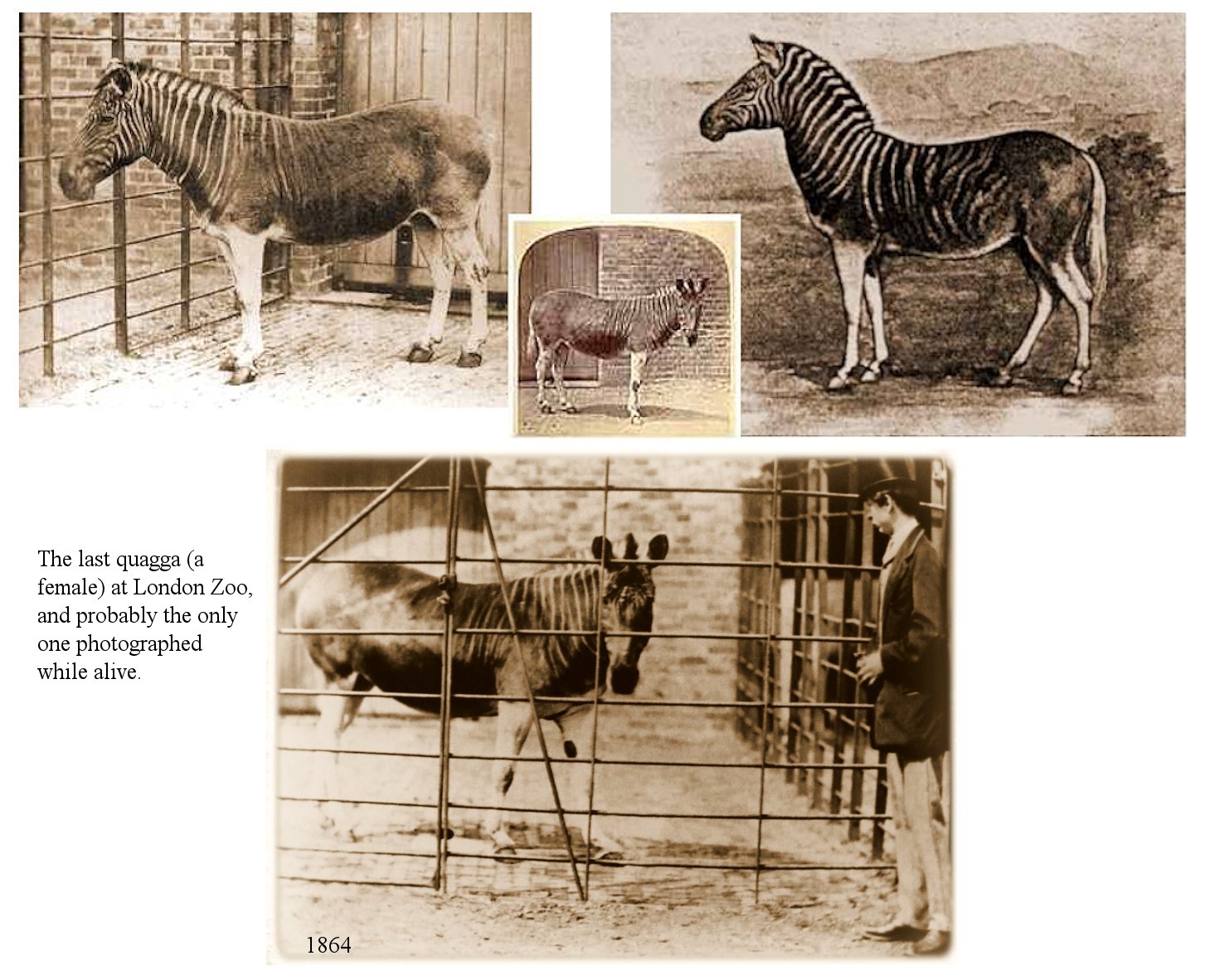
Captain M (Matthew) Horace Hayes's "Veterinary Notes for Horse Owners" and wrote: "... Up to the end of the first half of last century [the Quagga] was found in immense numbers in South Africa, and appears to have become extinct about the year 1870. The last specimen in England died in the London Zoological Gardens in 1864. It was a strong, somewhat heavily built animal, slow of pace for a wild member of the Equidae, and comparatively docile. " A pair of imported Quaggas were in the early part of the last century driven about London in a phaeton by Sheriff Parkins. Lieut. Col. C. Hamilton Smith, in his unpublished volume on Equidae, 1841 states that he drove one in a gig, and that its mouth was as delicate as that of a horse. He further stated that it had better quarters and was more horse-like even than Burchell's zebra, and added: 'It is unquestionably the best calculated for domestication, both as regards strength and docility' " (Tegetmeier and Sutherland) Owing to its deficiency in speed and alertness, and to the value set on its hide by the Boers and on its flesh by their Hottentot servants, it was finally exterminated by the settlers and natives. No attempt was made by naturalists to save this animal from extinction."
From Rev JG Wood’s “Illustrated Natural History” (1853, 1874): The QUAGGA looks at first sight like a cross between the common wild ass and the zebra, as it only partially possesses the characteristic zebra-stripes, and is decorated merely upon the hind and fore-parts of the body. The streaks are not so deep as they are in the zebra, and the remainder of the body is brown, with the exception of the abdomen, legs, and part of the tail, which are whitish-grey. The Quagga lives in large herds, and is much persecuted by the natives of Southern Africa, who pursue it for the sake of its skin and its flesh, both of which are in high estimation.
The quagga in Amsterdam Zoo - Natura Artis Magistra (known as "Artis") - was part of an animal exhange between Antwerp (offering a quagga, a blue gnu, a Canadian crane, and a pink pelican) and Amsterdam (offering a young plains zebra and 80 Java sparrows). The quagga, gnu, crane, and pelican reached Amsterdam in May 1867 and ln 1880, Winker, an honorary member of the zoo described her as "This beautiful animal is a mare: she is very tame and even allows strangers to pat her. I did it more than once with her keeper standing right next to me, holding a piece of bread in his hand."
In January 1870, Manders’ Menagerie announced a Grand State Procession in Liverpool that included a herd of both zebras and quaggas. This is interesting because it distinguishes between the two animals. Quagga was still used as a synonym for Zebra, e.g. Chapman’s Quagga, Bonte Quagga. Unfortunately there are no drawings or photos, and because the public weren't familiar with the creatures, some circuses passed off zebrasses as quaggas. According to the Globe (17th January 1881, pg 2), Sanger’s Amphitheatre at Old Astley also boasted a quagga.
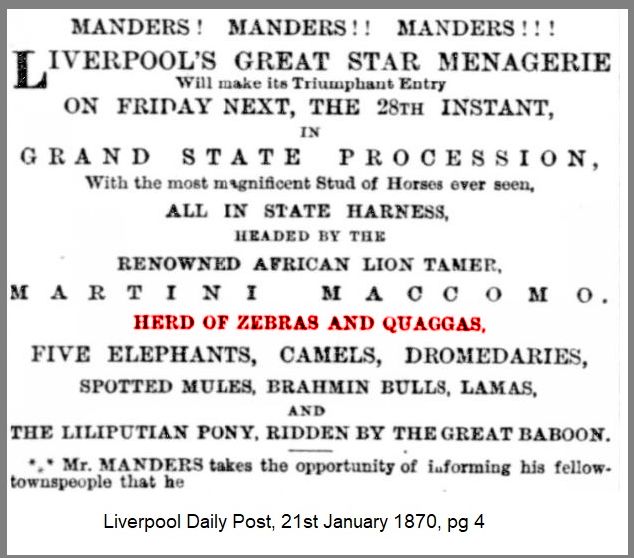
In the 1870s there was interest in the quagga as a potential replacement for horses in the USA where an equine disease was raging. Quaggas were immune to this disease. had the notion been taken seriously, quaggas would have been imported into the USA and bred there.
THE QUAGGA. Austin American Statesman, Texas, 3rd December 1872, pg 4. “[From the Cincinnati Commercial.] We mean to speak of an animal which would seem to be the very best substitute for the horse, if it be doomed to extinction. We refer to that excellent and elegant animal, the African quagga. Probably most of our readers know no more of the quagga than what they have learned by seeing its picture in the school geographies or in books of African travel. Many naturalists think that Africa was the original country of the horse, and there is very little doubt that it was in Northern Africa the horse was first brought under the subjection of man. In Africa, also, the quagga is found, and there in like manner, it has been domesticated. The quagga has the form, light figure and small head and ears of the horse. It is swift and strong, docile and obedient, and easily domesticated. It is capable of every variety of service performed by the horse, and naturalists say that by a little care on the part of man it might be rendered an exceedingly valuable beast of burden. It is about four feet high at the shoulders and neck, has slender legs and an asinine tail. It is an exceedingly beautiful animal. Its neck and fore parts are dark brown, elegantly striped with broad black bands; 1t has a dark line on the back; its hinder parts are light brown and it has white legs.
Buffon believed that the quagga was originally a hybrid between the horse and zebra; but, if this be so, its hybridity has not interfered with its permanent powers of propagation. It has an advantage over the horse, in that its flesh is savory though of rather course fibre, which makes it all the more attractive to the natives. The horse has been eaten, and, at the present day, is used for food to some extent in Paris; but horse meat is too rank for the palate, and the attempts of French savans to introduce it among the higher classes have not been successful. There would be no such difficulty in regard to the quagga. Quaggas are found wild in large herds on the plains of Southern Africa; and though swift and alert, they are not hard to catch. They could be brought to this country by the thousands in the course of a year or two. Some years ago an Englishman took a number of quaggas to London, and the people were delighted at seeing in the streets a team of quaggas harnessed to a curricule. We suppose it must be quite evident by this time that if the horse disease should threaten to place our equine friends among the extinct species, the best substitute for them would neither be the ox, the camel or the elephant, but the quagga. Why wouldn't it be a good idea to try the quagga anyhow?”
THE COMING HORSE. Wichita Eagle, Kansas, 9th January 1873, pg 1.: “The grievous disease which is at present affecting the equine population, and seriously incommoding those other kinds of population which pertain to the human species, suggests the inquiry whether or not the horse cannot be improved upon. We are prepared to give a hint in that direction. Divers and sundry most learned naturalists are of the opinion that the horse originated in Africa, and was there first brought into subjection to man. And in Africa there is to be found a sort of revised and improved though condensed edition of the noble animal whose coughs and sneezes now echo dismally through our streets. This edition is called the quagga, Buffon believed the quagga to have been originally a hybrid between the horse and zebra, but if so the hybridism has not destroyed the procreative powers of the quadruped. It retains all the principal characteristics of the horse, with the exception of the tail, which is unmistakably asinine. The legs are slender and well shaped, the head and ears small and beautifully proportioned, the body muscular though slight, and the eye remarkably brilliant and intelligent. The neck and fore parts are dark brown. striped with broad black bands, the hinder parts are light brown and the locomotive apparatus is white. The chief disadvantage under which the quagga labors is in size, it being only about four feet in height. This drawback is at least partially counterbalanced by the fact that the flesh can be eaten with pleasure and profit. It is very sweet, though somewhat coarse in texture, and the natives are remarkably fond of if, the epicures of Paris have declared it to be infinitely better than the majority of boarding-house beef.
But the most important recommendation of the quagga is that this docile and serviceable beast is proof against all attacks of epizootic. In Africa, as in America. the horses and the mules succumb easily to the detestable disease of distemper, but the gay and festive quagga laughs it to scorn. No premonitory sneeze, no threatening couch, no sickly sweat ever disturbs his equine equanimity. He as always ready for work or play, is never troubled by any sort of disease, and having reached the alloted age of his life – fifteen years - dies suddenly and without making any fuss or expense about it. A few years ago an Englishman delighted the Londoners by driving a well broken team of quaggas through Rotten Row and Hyde Park, where they displayed their strength to the satisfaction of all spectators. If, as some veterinary savans declare, epizootic is likely to become as much of an institution in the land as smallpox and measles, the sooner we can commence the importation and propagation of quagga is certainly to be preferred to the four legged invalids which now surround us.”
The News and Herald, Winnsboro, South Carolina, 11th December 1880 wrote “The quagga and the dauw, both inhabitants of South Africa, resemble the zebra, but are not so regularly striped nor so brilliant in coloring. They are not so vicious in character, and are capable of being tamed. The quagga is made useful by the settlers near the Cape of Good Hope and is taught to draw and carry burdens. A settler once captured a zebra when it was a colt. The animal accustomed itself to captivity, and appeared so good natured that its owner thought to make it as useful us the quagga. As a trial, he bridled it one day und jumped on its back. The animal at once began to rear furiously, and rushed with its rider into a deep river. The man clung desperately to the furious little beast, and was safely carried to the shore. But when he dismounted, the zebra turned in a rage, and suddenly bit his ear off. After that he concluded to remain content with his quagga.” But contrast this with an article in The (London) Daily Telegraph, 10th August 1889, pg 5: “The quagga or onager of Cape Colony and the Orange Free State is said by Mr. Cornwallis Harris in his ‘Portraits of game and Wild Animals of Southern Africa,’ to be one of the bravest and most fearless quadrupeds in creation. He is not to be confounded with the zebra, who is rather larger in height and heavier in build than the quagga, with whom he shares the incapacity to be domesticated . . . far from bowing their head to the yoke, the quagga and the zebra cannot catch sight of a man, their ruthless enemy, without showing him a clean pair of heels.” It is possible that that the quagga learned to fear man because of the hunting.

The commercial importance of the dead quagga is shown by the advert from 1884 in various British newspapers. For example: “George Day begs to call special attention to his Celebrated ‘QUAGGA’ Brand of Gentleman’s BOOTS. The ‘Quagga’ Leather is admirable for its very fine texture, and with G. DAY’s new mode of dressing is rendered beautifully soft, and suitable for the most tender feet, and at the same time is, without exception, by far the most durable Leather which is dressed. GEO. DAY guarantee the ‘Quagga’ Leather for appearance, durability, and especially as a Waterproof Leather, to excel Porpoise and all others, and he has much pleasure in announcing the acknowledged fact that no Gentleman’s Boots sold at 18s 6d are equal to his celebrated Quagga Leather.”
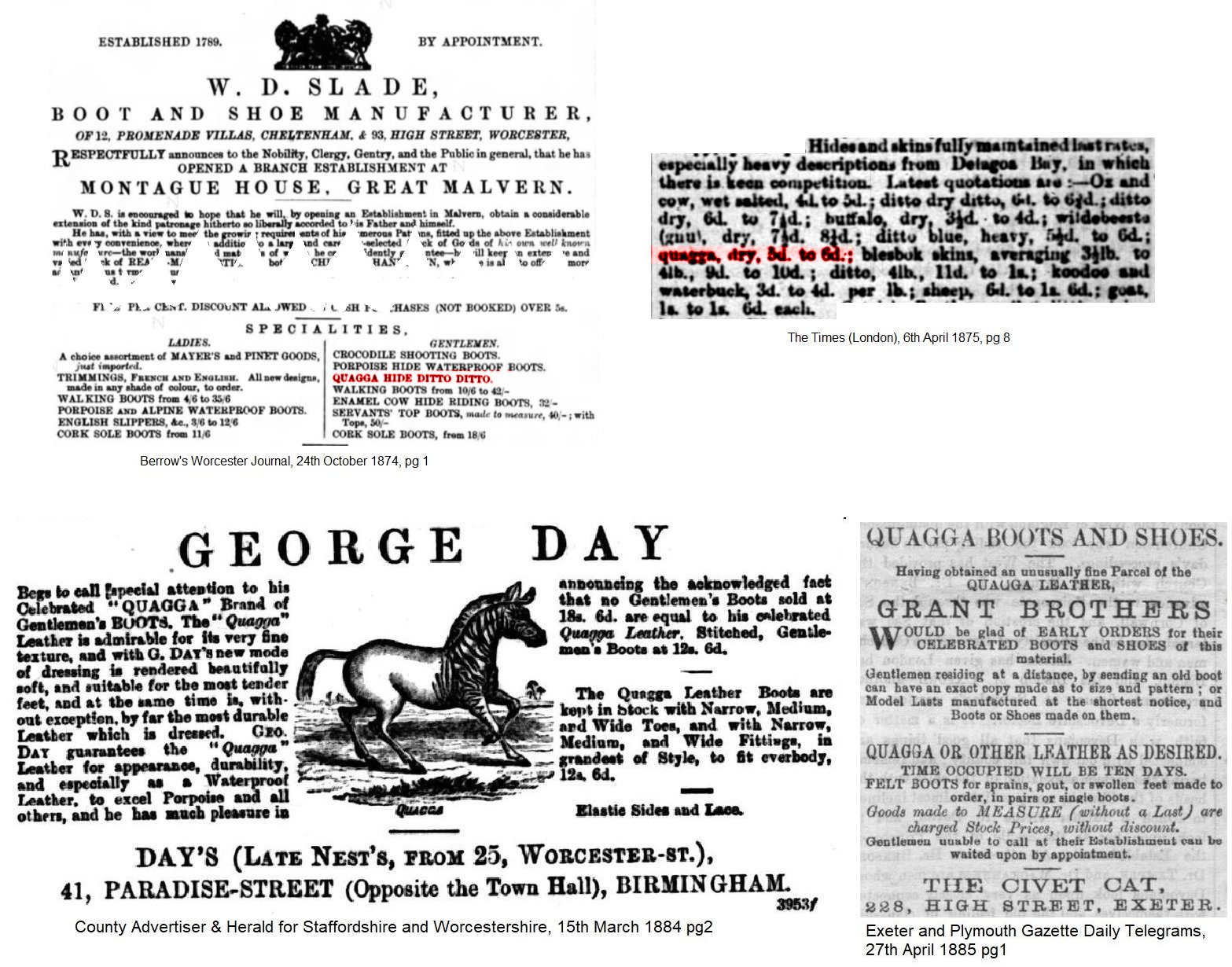
FASHION HAS KILLED THE QUAGGA. Ulster Echo, 14th December 1886, pg 4 (reprinted in various others in 1884 & 1885): “It is stated that the quagga, the beautiful wild striped ass of South Africa, has suddenly ceased to exist. The bootmakers of London and New York wanted his skin for a particular kind of sportsman’s boot, and he consequently passed away out of zoology. There may be a few left on the highest and wildest plateaus, but the Boers, tempted by the high prices, have extirpated the herds which only ten years ago existed in South Africa.”
EXIT QUAGGA. The Globe, 8th December 1886, pg 1: “Nothing can convey a better idea of the astounding rapidity with which the nobler game are being cleared from the face of the earth and especially in South Africa and North America than a chat with a London hide broker, or a visit to the crowded leather warehouses and wharves of Bermondsey. A firm of hide brokers has for some two or three years past had a standing order to obtain in one lot for some continental clients 500 quagga skins. Ten years ago such an order could easily and rapidly have been executed, but now it is an impossibility, for instead of arriving as they used in hundreds and thousands from South Africa quagga hides now only appear in driblets of from 10 to 30 at a time, and then principally from the Zanzibar coast. In fact, the rolling plains of the Orange Free State and the High Veldt of the Transvaal, whereon the quagga, in company with wildebeests (gnus), blessboks, springboks, and ostriches formerly grazed in countless thousands, are now absolutely denuded of these beautiful creatures, and their ancient habitats know them no more. With the introduction of breechloading weapons the Boers began a war of extermination upon the fauna that formerly imparted an air of grace to many a dreary landscape, and the laden waggons of the “skin hunters” rolled incessantly to Port Elizabeth and other markets. Then English bootmakers made the discovery that the hides of the black wildebeest and the quagga - particularly the latter - made the finest quality of so-called porpoise hide, now much in request for walking boots, The new demand completed the ruin of these quadrupeds, which are now all but extinct south of the Tropic of Capricorn.”
The quagga is now considered to be a southern subspecies of the plain zebra found in the drier parts of South Africa, on grassy plains. Examination of portions of mitochondrial DNA and protein in the 1980's from a preserved skin showed that the Quagga diverged from the Plains zebra between 300,000 and 100,000 years ago (during the later Pleistocene). Its northern limit was the Orange River in the west and the Vaal River in the east; its south-eastern border appears to have been the Great Kei River. The last free quaggas were probably those caught in 1870 although a small population may have survived south of the Vaal river until the severe drought of 1878. The last captive quagga was a mare; she died on 12 August 1883 in Amsterdam Zoo, having been exhibited there since 9 May 1867. It was not realised that this quagga mare was the very last of her kind. It could, even then, have been saved by breeding it to the white-legged, white-tailed Burchell's zebra, itself destined for extinction a few decades later.
Burchell's Zebra was a subspecies of the Plains Zebra characterised by its unstriped legs and belly and its reddish brown body-stripes with paler "shadow stripes" in between on a cream or buff background colour. Its original range was mainly north of the Orange and Vaals Rivers, extending north into Botswana and the south-western Transvaal, and east to about Natal. It originally existed in vast herds, but by 1910 it was gone from the wild and the last known individual died in the Berlin Zoo in 1918.
Plains zebra are black and white with no shadow stripes, although individuals show some variation (sometimes attributed to throwbacks indicating interbreeding with quagga). Selective breeding of these throwbacks or variant individuals could bring back both the Burchell's race of Plains Zebra and the Quagga; this would involve capturing and breeding together Plains zebra that lack stripes on their hindquarters and legs. Some progress has already been made on this, producing individuals that lack stripes on their legs and rumps. However, will selective breeding really bring back the quagga or will it just produce something that resembles it?

AN EXTINCT CREATURE. THE LAST QUAGGA IN THE ZOOLOGICAL GARDENS OF LONDON. The Evening Express, 17th March 1891, pg 7: “The frontispiece to the last Year-Book of Photography represents the last quagga which was to be seen in the Zoological Gardens of London, and which was photographed in 1873 by Mr. Frederick York, who now possesses five negatives of the animal. This quagga was received at the Gardens September 4, 1858; the date of its death there is unrecorded. The quagga is, or was, a native of South Africa, and nearly allied to the zebra. Quaggas were more readily tamed than the true zebra; in fact, in the early part of the present century, two of them were driven in Hyde Park by Sheriff Harkins. In length of ears and character of tail it more resembled the horse than the ass; still, to the popular eye the hinder half of the animal much resembled the ass, and the front half the zebra. It was heavier than the zebra, consequently was killed off more rapidly than is being the case with the zebra, by wild beasts, as the area in which such animals throve is being reduced by the extension of the limits of civilization. Supposing that any quaggas are still left, some ‘rich American’ might do worse than to offer a reward for their capture, and to start a quagga park.
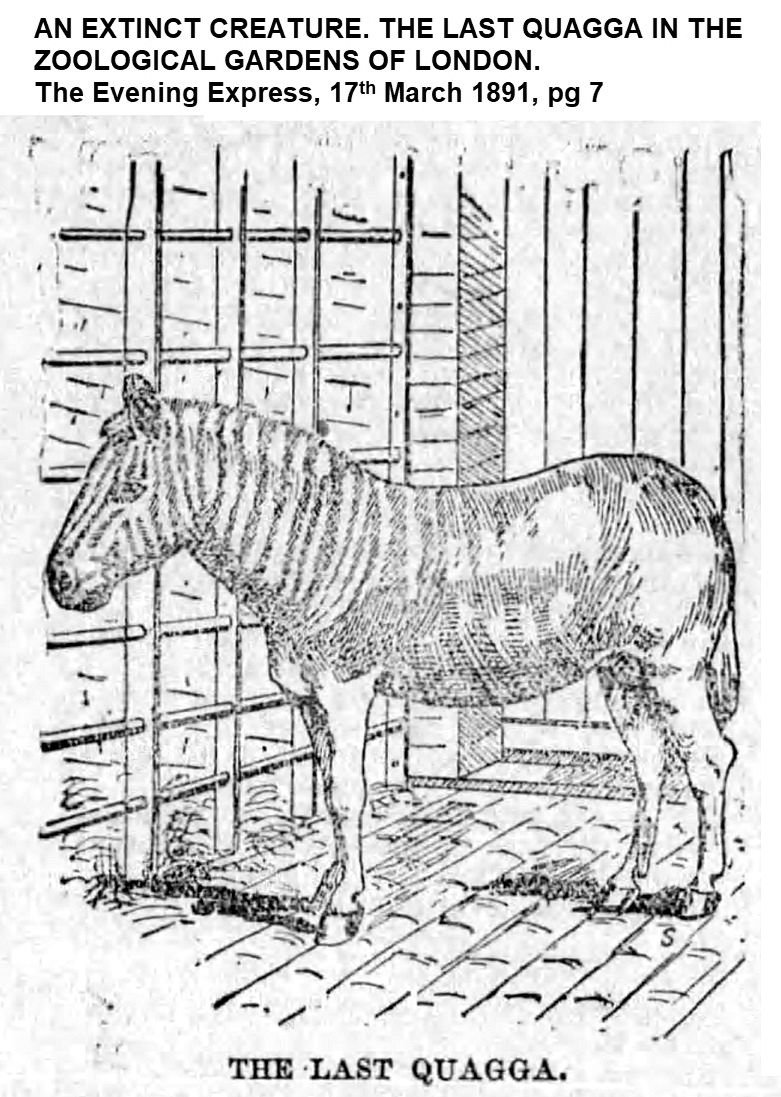
Mr. A. D. Bartlett, who has been superintendent of the Zoological Gardens for thirty-one years, and connected with the gardens for forty-five years, says that in its habits the quagga more resembles the ass than the horse, and that the one represented in our collotype print was donkey-colored from the neck. He has never seen a very young one, but supposes that at birth it may have been striped all over. The dun-colored pony of Norway, when young, has striped legs, and he suspects that the original horse was a striped animal. There is no true wild horse; those supposed to be such are the descendants of tame horses which have escaped from captivity. He says that there is no evidence that any quagga is now living, but Africa is a large place, so that it is impossible to say with certainty that the animal is extinct; he does not think that one has been seen for some years. The Burchell zebra is now by mistake commonly called the quagga in South Africa. Supposing that photography had been known in time for one man to have photographed the last dodo, his name would have been hauled down to posterity in connection therewith for all time. Mr. York may be in that happy position in relation to the last of the quaggas, and can rejoice - we say with all respect - in the possession of the privilege of riding to immortal fame on the back of a striped jackass.”
London Zoo had three quaggas at over the years:
The first was purchased from a Mr. Thomson and lived in Regent's Park for less than three years from 25th November 1831 to 18th July 1834. Its mounted skin is at the Natural History Museum, South Kensington. (The whereabouts of its skeleton is unknown; there is a quagga skeleton at South Kensington, but it is from a different ZSL quagga to the mounted skin.)
The second was a female, purchased from the famous animal dealer Jamrach. It lived at London Zoo for more than twenty-one years from 15th March 1851 until her death on 7th July 1872. This was the only living quagga known to have been photographed. Its mounted skin went to the Royal Scottish Museum, Edinburgh and its skeleton went to the Peabody Natural History Museum at Yale University, U.S.A.
The third was a male presented to the zoo by Sir George Grey, who donated numerous South African animals. It lived at the zoo from 4th September 1858 until 10th June 1864, but had to be destroyed after seriously injuring itself. Its mounted skin went to the zoology museum at Weisbaden in Germany and its skeleton went to the Natural History Museum at South Kensington. Had it not died, the zoo would have been able to breed quaggas.
There are 23 mounted specimens, 7 skeletons and 13 skulls in museums around the world. Quagga exhibits are held at Amsterdam and Lieden (the Netherlands), Bamberg, Berlin, Darmstadt, Frankfurt, Mainz, Munich, Stuttgart, Tübingen and Wiesbaden (Germany), Basel (Switzerland), Cape Town and Pretoria (South Africa), Edinburgh (Scotland), Kazan (Russia), Exeter London and Tring (England), Lyon and Paris (France), Milan and Turin (Italy), New Haven and Philadelphia (USA), Stockholm (Sweden) and Vienna (Austria). The variability of striping suggests that some mounted specimens may be quagga x Burchell's zebra hybrids; these possibly interbred naturally where their ranges overlapped or artificially in captivity.
From “Kloof and Karroo: Sport, Legend and Natural History in Cape Colony, with a notice of the game birds, and of the present distribution of antelopes and larger game" by H.A. Bryden (1889)
The zebra, as all naturalists are aware, differs widely from the zebra of Burchell (Equus Burchellii), (the bonte quagga of the Boers, the piitzi of the Bechuanas), and from the quagga (Equus quagga) or quacha of the Hottentots. In the first place, its colour and markings are widely different. The zebra's body colour is of a beautiful silvery white, and the black markings are distributed more evenly, and extend to every part except the stomach and the inner parts of the thighs; even the legs are perfectly ribanded in black and white. Upon the light clean head (with the exception of the ears, upon which the black and white markings continue) the markings change to brown, while the muzzle is of a rich bay tan colour. The ears and tail are distinctly asinine, while in both Burchell's zebra and the quagga they are of the equine type. In height, too, the zebra, which only averages some twelve hands at the shoulder, is inferior by some six inches to its congeners. Contrasting, therefore, the colour and markings of the true zebra with the sienna body colour and brown striping of Burchell's zebra, and the reddish-brown of the quagga - whose stripings, by the way, only extend to a little behind the shoulders – and further noticing its distinctive asinine type when placed side by side with the more equine look of the other two, wide differences will be readily distinguished.
The quagga and Burchell's zebra, too, are essentially lovers of the wide and open plains, while the zebra proper, as I have pointed out, never by any chance leaves its mountain home, unless possibly to trek from one neighbouring range to another, and then only under cover of night. I may remark here, that the quagga has only become extinct in the Cape Colony within the last twenty years, but Burchell's zebra must have disappeared long previously. That the latter animal did exist south of the Orange River in large numbers I have little doubt, from the perusal of Lieut. Paterson's very interesting "Journeys to the Country of the Namaquas and to Kaffraria in 1777-8-9," for he speaks of what was evidently Burchell's zebra being met with in large numbers in the Namaqua country, though at that time the animal was unconnected with the name of Dr. Burchell.
[. . . ] The Quagga (Equus quagga), or quacha, is now quite extinct within the Colony. Formerly it abounded on every plain, and with a very little preservation, might even now be adorning the landscapes. The last observed on the Great Karroo were three that still remained, in 1858, near the Tiger Berg, in the neighbourhood of Aberdeen. In a subsequent chapter I have dealt at some length with the decline and fall of this handsome and interesting quadruped. I was told not long since that quaggas were still to be found in the Outeniqua district, but I subsequently ascertained that my informant had confounded them with zebras, which did undoubtedly exist there.
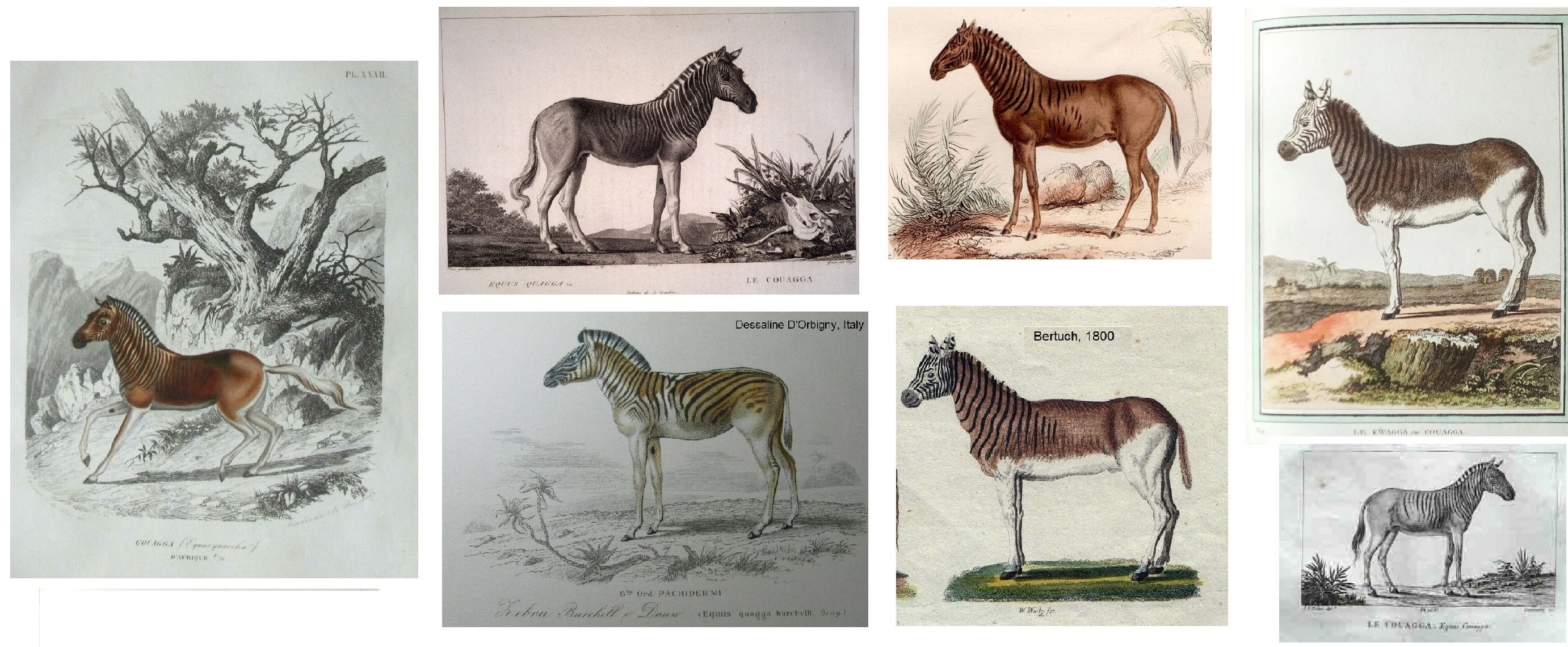
CHAPTER XXII. THE EXTINCTION OF THE TRUE QUAGGA (EQUUS QUAGGA).
IT is a melancholy thing to chronicle the final disappearance from its ancient primeval habitat of one of the most beautiful forms of animal life; but there is now, I fear, no longer any reasonable doubt that the true quagga – quacha of the Hottentots – Equus quagga of Linnaeus – must be numbered in the increasing catalogue of extinct creatures.
During my former stay in Cape Colony, I made many inquiries in various parts of the country as to the date of the final disappearance of this animal from within the colonial limits, and from the information I then obtained, I should be inclined to place its extinction south of the Orange River, between the years 1860 and 1865. Cape Colony is a wide territory, and its remote parts are to this day almost as unnoticed and unknown as they were at the beginning of the century; and for this reason, it is very difficult to place exactly – even to a few years – the actual extinction of its disappearing fauna. In the Orange Free State, where it roamed, not so very many years since, even more freely than of old in the Cape Colony, the quagga lingered to a much later period; but even there it would seem for some years past to have become quite extinct. In this opinion I am fortified by Mr. F. C. Selous, who told me only a few months since, just before his last return to Africa, that he had not heard of a true quagga in the Free State for some years, and doubted not that it had become completely exterminated. Other South African informants confirm this opinion.
It may be well, before proceeding further, to remind readers that among all South African interior hunters and traders, Burchell's zebra – called by the Boers, from its fuller markings, the bonte quagga (literally the pied or spotted quagga), in contradistinction to the now extinct true quagga – is also invariably, if erroneously, called a quagga. In this way a good deal of confusion has arisen, and many people, no doubt, still suppose that the rarer true quagga is yet plentiful in the distant territories beyond the Orange River.
I find that among hide-brokers and others in the skin and leather trades, this confusion has also arisen, and that the skins of the Burchell's zebra, which still arrive in this country in large numbers from East Africa, are invariably classed as "quaggas."
The true quagga, as a matter of fact, was easily to be distinguished from Burchell's zebra, by the paucity of its stripings, which extended only to the centre of the barrel, and by its general body colour – a rich rufous brown, fading to white underneath. Burchell's zebra, on the contrary, is completely striped all over the body (save as to the legs), while its body colour is yellowish sienna. The true zebra (Equus zebra), formerly the rarest of the hippotigrine group, differs widely, again, from both the abovementioned animals. In this species, as I have before pointed out, the body colour is silvery white, the stripings are black, and extend all over the body and legs, while the ears and tail are far more asinine. It may further be noted that, amongst the zebras called Burchell's, a variety exists – known as Chapman's variety – in which the legs are striped as completely as in the true or mountain zebra (Equus zebra). This variety is comparatively scarcer but not so scarce, Mr. Selous tells me, as is generally imagined. In equatorial Africa, indeed, it would seem to be fairly common.
It is, I think, unquestionable that, so far as mere beauty is concerned, Burchell's zebra (the zebra of the plains), the commonest of the group, carries away the palm. The type is more equine, the ears are smaller, and the tail more bushy than in the true zebra; while the colouring is, to the average eye, richer and more attractive. Thus much I am free to admit. On the other hand, I am bound to say of the true zebra that, viewed as I have viewed it in Cape Colony, revelling in the wildest, most rugged, and remotest portions of its own-loved mountain habitat, there are few prouder and more beautiful objects in animate nature.
Burchell's zebra, of which there are always some good specimens to be seen at the gardens of the Zoological Society, though for the last hundred years not found south of the Orange River, has a widely extended range over all Africa, from the Orange River to far north of the equator. The true zebra would seem to be confined mainly to the extreme north and south of the continent; its peculiar and most favoured habitats being the Cape Colony, and Namaqualand and Damaraland in the south, and Abyssinia and Shoa in the north.
The range of the true quagga, the subject of this chapter, was even more arbitrarily defined. This animal, formerly so abundant upon the far-spreading karroos of Cape Colony and the plains of the Orange Free State, appears never to have been met with north of the Vaal River. Its actual habitat may be precisely defined as within Cape Colony, the Orange Free State, and part of Griqualand West. I do not find that it ever extended to Namaqualand and the Kalahari Desert to the west, or beyond the Kei River, the ancient eastern limit of Cape Colony, to the east. In many countries, and in Southern Africa in particular, nothing is more singular than the freaks of the geographical distribution of animals. A river, or a desert, or a belt of sand or timber – none of which, of themselves, could naturally oppose a complete obstacle to the animal's range - is yet found limiting, thus arbitrarily, the habitat of a species. I have thought a good deal over this circumstance, and I confess to being completely puzzled for a satisfactory explanation of it, more especially in the cases of the zebra, Burchell's zebra, quagga, giraffe (said, in common with Burchell's zebra, to have been never found south of the Orange River), the blessbok, bontebok, black wildebeest (white-tailed gnu), and other antelopes.
As the quagga may now be fairly considered as absolutely extinct as the dodo – for alas! although easy enough to destroy, no human skill can ever restore it to its natural haunts – it may not be out of place here to record its exact description, taken from Cornwallis Harris's " Portraits of the Game and Wild Animals of Southern Africa." " The adult male stands four feet six inches high at the withers, and measures eight feet six inches in extreme length. Form compact. Barrel round. Limbs robust, clean and sinewy. Head light and bony, of a bay colour, covered on the forehead and temples with longitudinal, and on the cheeks with narrow transversal stripes, forming linear triangular figures between the eyes and mouth. Muzzle black. Ears and tail strictly equine; the latter white and flowing below the hocks. Crest very high, arched, and surmounted by a full standing mane, which appears as though it had been hogged, and is banded alternately brown and white. Colour of the neck and upper parts of the body dark rufous brown, becoming gradually more fulvous, and fading off to white behind and underneath. The upper portions banded and brindled with dark brown stripes, stronger, broader, and more regular on the neck, but gradually waxing fainter, until lost behind the shoulders in spots and blotches. Dorsal line dark and broad, widening over the crupper. Legs white, with bare spots inside above the knees. Female precisely similar."
Sir W. Jardine describes the quagga as equal or superior in size to the Burchell's zebra, and as " still more robust in structure, with more girth, wider across the hips, more like a true horse;. the hoofs considerably broader than in the true zebra, and the neck full; the ears rather small." The same writer speaks of it as best calculated for domestication of the zebra group, both as regards strength and docility. He instances the facts, that the late Mr. Sheriff Parkins used to drive a pair of quaggas in his phaeton about London, and that he himself had been drawn by one in a gig, " the animal showing as much temper and delicacy of mouth as any domestic horse."
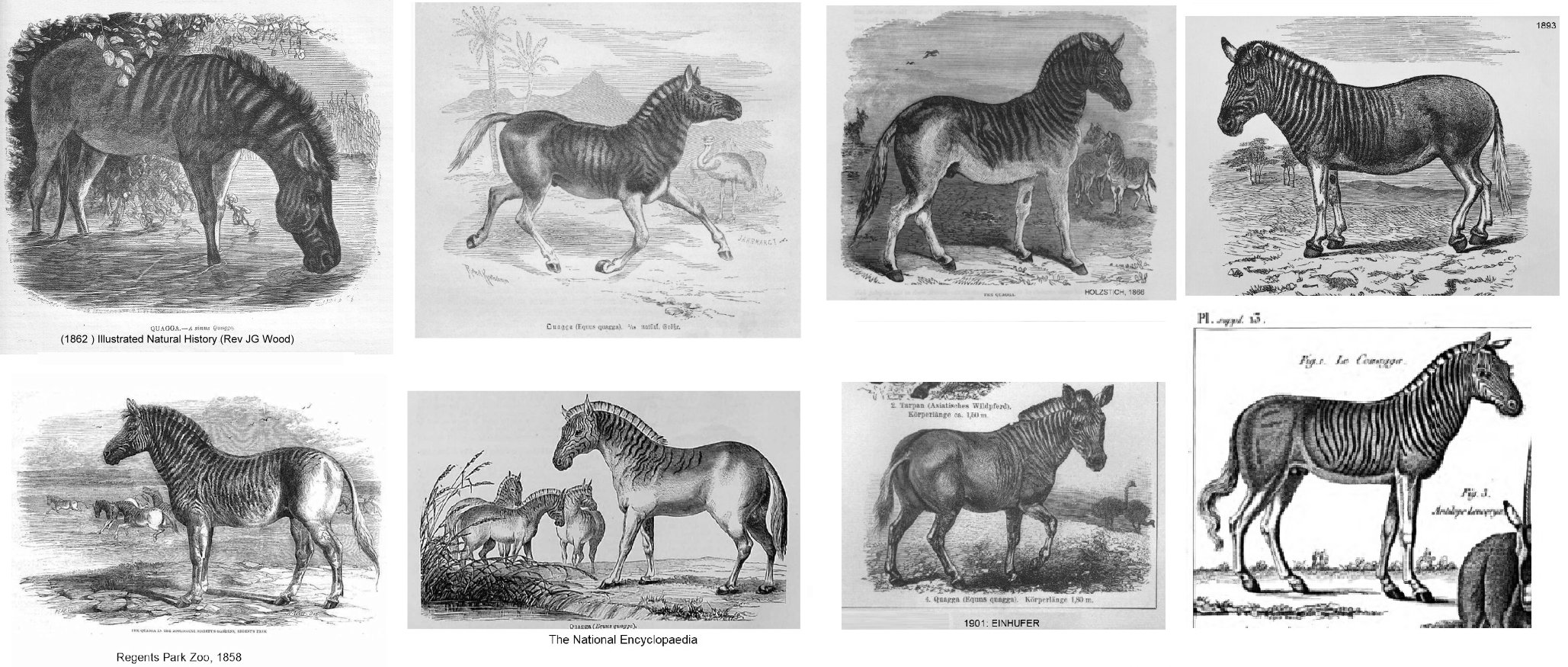
Barrow, in his excellent " Travels into the Interior of Southern Africa " (1797-8), writes of the quagga as " well-shaped, strong-limbed, not in the least vicious; but, on the contrary, soon rendered by domestication mild and tractable; yet, abundant as they are in the country, few have given themselves the trouble of turning them to any kind of use. They are infinitely more beautiful than, and fully as strong as, the mule, as easily supported on almost any kind of food, and are never out of flesh."
On the other hand, although undoubtedly, if taken young, more easily tamed than the fierce true zebra, in its wild state the quagga must have been .an extremely awkward customer when wounded. I have heard numerous anecdotes from old colonists of the ferocity of this animal and the zebra in the wild state. Cornwallis Harris instances the death of a native servant, whose skull was completely smashed by the kick of a quagga, and mentions a narrow escape of his own; and he further speaks of his having seen " a wretched savage, every finger of whose dexter hand had been stripped off by the long yellow teeth of a wounded male."
The courage of the quagga, reputed by Jardine to be the boldest of all equine animals, attacking hyaena and wild dog without hesitation," was, in the old days, to some extent taken advantage of by the Dutch colonists, who are reported to have used them in a domesticated state " for the purpose of protecting their horses at night, while both are turned out to grass." I have not been fully able to satisfy myself that this account of Jardine's was correct. The Boers' ancient habit of kraaling all their flocks and herds, to insure them against the nocturnal attacks of dangerous animals, would, I think, militate against the adoption of this plan to any great extent. Still, in some instances, it may have occurred.
The vast karroos of the Cape Colony in the earlier half of this century, and the plains of the Orange Free State until about the year 1860, furnished the most extraordinary spectacles of teeming animal life that the world has ever seen. At one time the supply of game, which literally swarmed upon these plains, jostling one another in actual millions, seemed practically inexhaustible. No other part of the world could ever vie with these favoured regions in the wealth and variety of their fauna. Elevated table-lands, a singularly healthful climate, and abundance of pasture, seem to have here united to attract and sustain an unparalleled collection of animal life. Brindled and white-tailed gnu, Burchell's zebras, quaggas, springbok and blessbok, and the ever-attendant lion, formed the main body of all these beasts of the chase; ostriches, elands, hartebeests, gemsbok, and bontebok, furnished ample battalions in support. Old colonists have often spoken to me of the quantities of game thus existing as being positively inconceivable; but improved arms of precision, and the ruthless skin-hunters, have done their work, and well nigh all these crowds of game have vanished. In the Cape Colony, the beautiful springbok yet remains in considerable abundance to remind one of the past; but the Free State is now almost entirely denuded of its former glorious fauna. Nature, upon these crowded plains, seems to have provided periodical and ravaging diseases to keep down the superabundance of life, and the brand-sickte, or burning sickness, amongst others, killed off thousands of game at various seasons. It is a singular circumstance that, although inhabiting the same plains in the Orange Free State, the quagga was never to be found mixing with its near relative, the Burchell's zebra. It was, however, curiously enough, almost invariably found associating with the black wildebeest (the white-tailed gnu, Connochsetes gnu, now also becoming extremely scarce) and the ostrich. The Burchell's zebra for its part is, and was, usually seen in company with the blue wildebeest (brindled gnu, Connochsetes gorgon); and the ostrich would seem to have been a companion common to both animals.
The downfall of the quagga first began, as it ended, at the hands of the Boers. In the old days, the Cape Dutch farmers, to save their flocks and herds, which they considered far too valuable to waste on the feeding of their slaves and retainers, usually shot the quagga for this purpose. The oily yellow flesh of this animal, disdained by themselves amid the abundance of more toothsome game, was set apart for the food of their Bushmen and Hottentot servants, and Mozambique slaves, and very large quantities were thus annually sacrificed. Although this practice gradually thinned it oft the Great Karroo, even so lately as Gordon Cumming's day (1843) the quagga was found upon the northern plains of the Cape Colony in considerable numbers. Upon the Great Karroo itself, the last quaggas ever seen were shot near the Tiger Berg, a solitary mountain, springing from the plains not far from Aberdeen, in the year 1858. There were two then remaining, and my informant, with whom I stayed while in Cape Colony, near this very spot, well remembered their being shot. Further north in the Colony, as I have said, they lingered to a still later date. Their skins were used for grain sacks, and I have seen old quagga-skin sacks still in use in a Dutch farmhouse.
Some twenty or twenty-five years back the Boers of the Orange Free State suddenly awoke to the fact that in the skins of the quagga and Burchell’s zebra and other game they possessed a mine of wealth, and they at once set about the task of exterminating these animals. The mine took some years to work out; but the task is now complete, and many a farmer looks back with keen but unavailing regret to the glorious hunting veldt of the past. In the hide trade the skins of these animals have been in great demand for years past, and the avaricious Boers were not slow to avail themselves of this demand. The bone-strewn plains of the Free State bear miserable testimony to the feverish haste and deadly methods of the skin-hunters of the past twenty years. The work was done with business-like skill and parsimony. Bullets were carefully cut out of the carcass for future use, and a sufficient number of skins having been prepared, the waggons were loaded up and slowly driven down country to the coast.
From the point of view of the naturalist, the final disappearance of the true quagga is a fact full of melancholy interest. That an animal so beautiful, so capable of domestication and of use, and to be found not long since in so great abundance, should have been allowed to be swept from the face of the earth, is surely a disgrace to our latter-day civilisation. No human effort can now recall this magnificent form – it is gone for ever, after an existence of untold thousands of years upon its spacious plains. One can only hope that the African elephant, the eland, and other useful creatures now fast disappearing, will not be suffered to vanish thus miserably.
I find that the true quagga has not often figured in the collection of the Zoological Society. There appear to have been but two specimens shown there: one, a female, purchased in 1851; the other, a male, presented by Sir George Grey (then Governor of the Cape) in 1858. These specimens have, of course, long since disappeared. I do not remember to have seen a stuffed specimen of the quagga in the Natural History Museum at South Kensington, although I believe a skin or skins formerly existed in the British Museum.
The name quagga is obviously a corruption of the Hottentot name for this animal, "quacha," derived from the animal's call or neigh. Pringle, the bard of South Africa, recalls this peculiar neigh in his poem "Afar in the Desert":
And the timorous quagga's wild whistling neigh
Is heard at the fountain at break of day.
Old hunters and colonists have described to me the curious single-file march of this animal when moving about its native plains, and the squadron-like wheel of the troop when disturbed. Cornwallis Harris seems to have noticed this trait. He writes thus picturesquely of it: "Moving slowly across the profile of the ocean-like horizon, uttering a shrill barking neigh, of which its name forms a correct imitation, long files of quaggas continually remind the early traveller of a rival caravan on its march."
Never more, alas! will this fleet and handsome creature scour its primeval karroos, or proudly pace in regular formation, or with its fellows wheel and charge like a regiment of cavalry. It has been the first of the matchless fauna of South Africa to disappear. That its extinction may serve as some sort of warning to wanton and ruthless destroyers of game, whether Boer or British, or of any other nationality, is devoutly to be hoped.
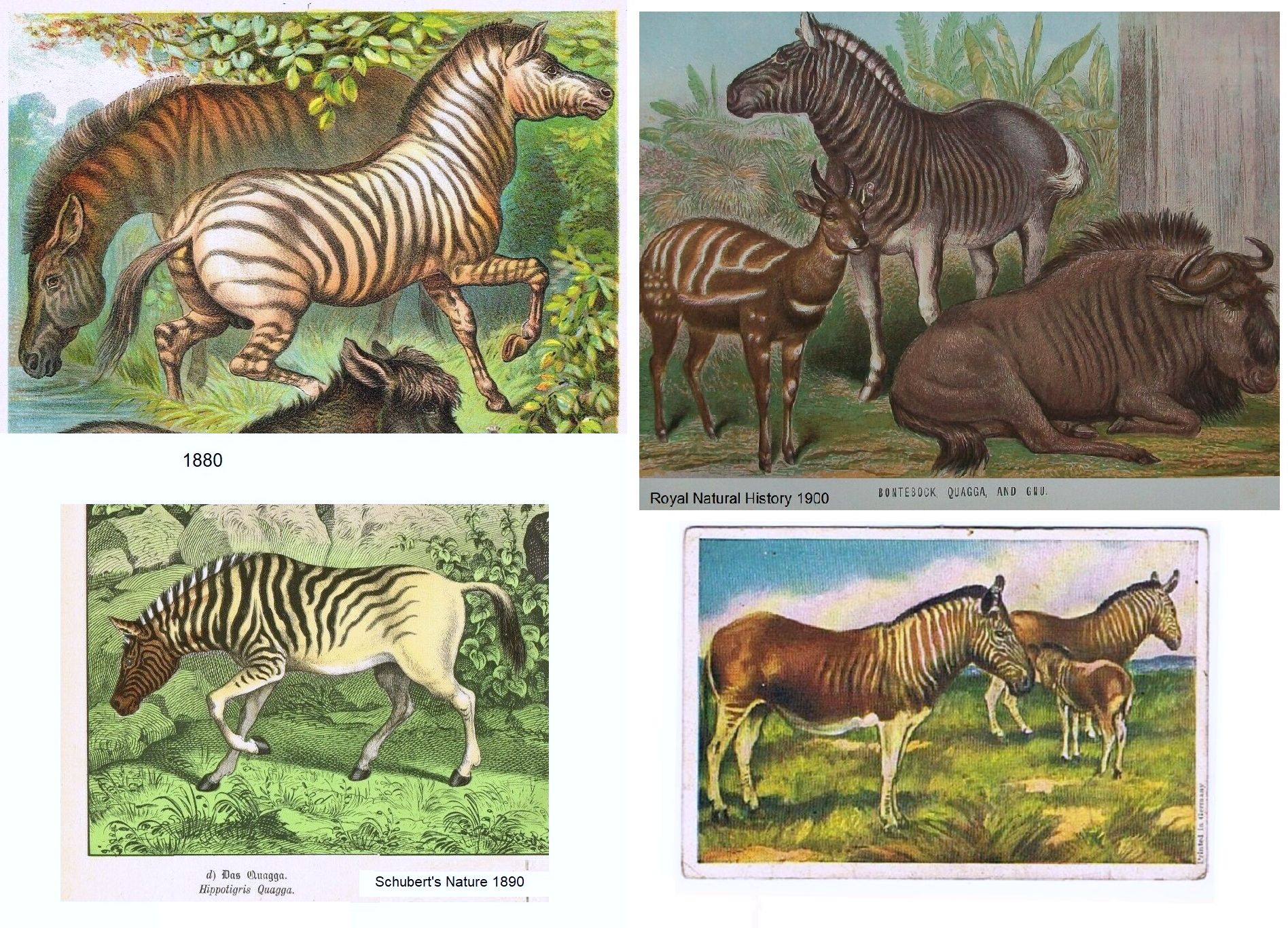
R I Pocock, writing in Harmsworth Natural History (1910), classed Burchell's and Chapman's zebras as quaggas while the species known today as the quagga was called Grey's quagga. He described numerous subspecies of quagga, many of which were merely pattern variations within a species. Pocock wrote:
"The trivial and scientific designations of the quagga (Equus quagga) are derived from the name quaha" or ‘quacha," given to South African representatives of the species in imitation of their cry. It so happens that the first example to be made known to naturalists cane from the Cape flats and is now extinct; but striped equine animals with the same cry and the sane structural characters are now known to range through the whole of East Africa from Abyssinia to Zululand, and thence westwards to Southern Angola. Distributed over an area so vast and so varied in its physical features and exposed to widely different conditions of climate and temperature, the species exhibits marked local variations in colour and pattern, forming distinguishable geographical races or subspecies. The northern and eastern races so far south as Mashonaland are fully striped with black and white or pale fawn to the hoofs ; but southwards from Mashonaland occur races in which the stripes exhibit more and more marked signs of disappearance from the legs, belly, and hind quarters; those that formerly inhabited Cape Colony, to which the name quagga was first applied, showing in some cases hardly a trace of striping even on the posterior part of the body. These, as well as some of the decidedly striped more northern races, were known to the Dutch colonists, who, by way of emphasising the difference, spoke of the latter as bontequaggas; but when the relatively less striped races became extinct, the term bontequagga dropped out of use amongst the Dutch, who to this day comprehensively speak of all the South African races as quaggas; and since no competent authorities now doubt that these animals belong to the same species as the existing North African and the extinct South African races, the scientific and vernacular term "quagga" may be extended to the whole series.
In the fully striped races of this species the stripes on the body extend to the median ventral line, those on its anterior half behind the shoulder-stripe, four or five in number, being vertical, while the remainder turn sharply backwards dorsally, no fewer than four forming a bold sweep back on to the hind quarters, this last characteristic being the distinguishing feature of the pattern of the species ; the stripes on the thighs are broad and on the legs numerous and close set the spinal stripe is distinct and widens behind over the saddle and croup, where it is usually separated from the adjoining stripes of the body and quarters. Of these northern forms the best known is Böhm’s quagga (E. quagga boehmi) from British and German East Africa. Nearly allied to it are Jalla’s quagga (E. quagga jallae) from Southern Abyssinia; and Crawshay’s quagga (E. quagga crawshayi) from Southern Nyasaland. Related to the last is a quagga from North Eastern Rhodesia to which the name annectans has been given, a race characterised by the great breadth of the dark as compared with the light stripes. South of the Zambezi in Mashonaland occurs Selous’s quagga (F. quagga selousi), of the same general stamp as Böhm’s quagga. In the latter faint stripes called " shadow stripes " are sometimes observable between the principal stripes on the quarters. These are also present in Selous’s quagga; but in more southern forms they increase in distinctness and extent concomitantly with the disappearance of the stripes from the legs. Chapman’s quagga (F. quagga chapmanni), which ranges from Damaraland to the Transvaal, differs from Selous’s quagga in having the legs, below the knees and hocks, sparsely striped. The reduction of the leg stripes is carried still further in Wahlberg’s quagga (F. quagga wahlbergi), from Zululand, a race which is also distinguished by the great reduction in width of the principal stripes upon the hind quarters; by the distinctness of the shadow stripes on this region, and by their forward extension to the withers.
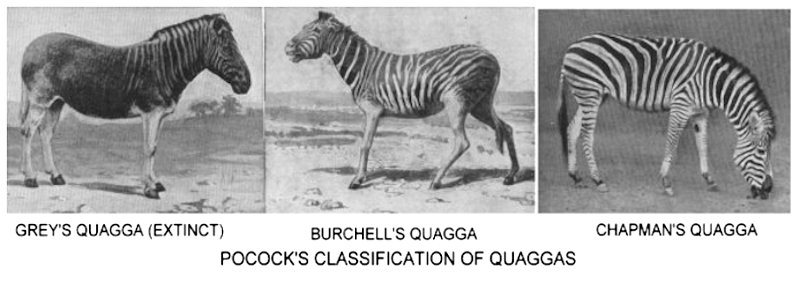
Still more different from the northern races is Burchell’s quagga (F. quagga burchelli), from Bechuanaland, in which the stripes have almost vanished over the hind quarters up to the root of the tail, and on the fore legs up to the shoulder, leaving the legs whitish and almost unstriped; the body stripes no longer reach the middle line of the belly, and the shadow stripes sometimes extend as far as the head. In some of these quaggas, too, the lighter areas are ochre brown, so that there is no longer the sharp contrast between the dark and light stripes seen in the northern types. The next stage in variation is reached by various races, all now extinct, which formerly ranged southwards from the Orange River Colony over Cape Colony to the flats round Cape Town. The typical quagga, of which only a coloured illustration is extant, was very like a dark-tinted Burchell’s quagga, except that the stripes over the croup were broken up into spots. In other races, as shown by mounted specimens, the obliteration of the pattern was carried still further, so that only the head, neck, and shoulders were distinctly marked; the tendency of the obliteration being to produce a nearly uniformly brownish, or in some cases chestnut, animal with pale legs. But even the few specimens of Cape Colony quaggas that have been preserved show practically a complete gradation from Burchell’s quagga to chestnut-tinted individuals with narrow dark stripes only on the head, neck, and shoulders.
Between eleven and twelve hands at the withers is the average height of quaggas. Adapted essentially for living in the plains, quaggas have broader hoofs than the mountain zebra and African asses; the ears are markedly smaller than in other African species of Equidae, and the callosities are intermediate in size between those of the mountain and Grévy’s zebras. The voice may be described as a ringing bark, comparable in shrillness to that of a small dog, and representable by the syllables "qua ha ha," "qua ha ha," rapidly repeated and sharply uttered, a cry quite unlike the neigh of a horse or the bray of an ass or of Grévy’s zebra. When South Africa was first colonised by Europeans, quaggas were exceedingly common on the flats and plateaus of Cape Colony, where they associated in troops, quite commonly mixed with ostriches, white-tailed gnus, and other antelopes. They were finally exterminated by the Boers in the Cape and Orange River Colonies; and the same fate is rapidly overtaking Burchell’s quagga of Bechuanaland, of which, as in the case of the Cape Colony races, only a few mounted specimens have been preserved, although a few may still be seen in various menageries of Europe and America.
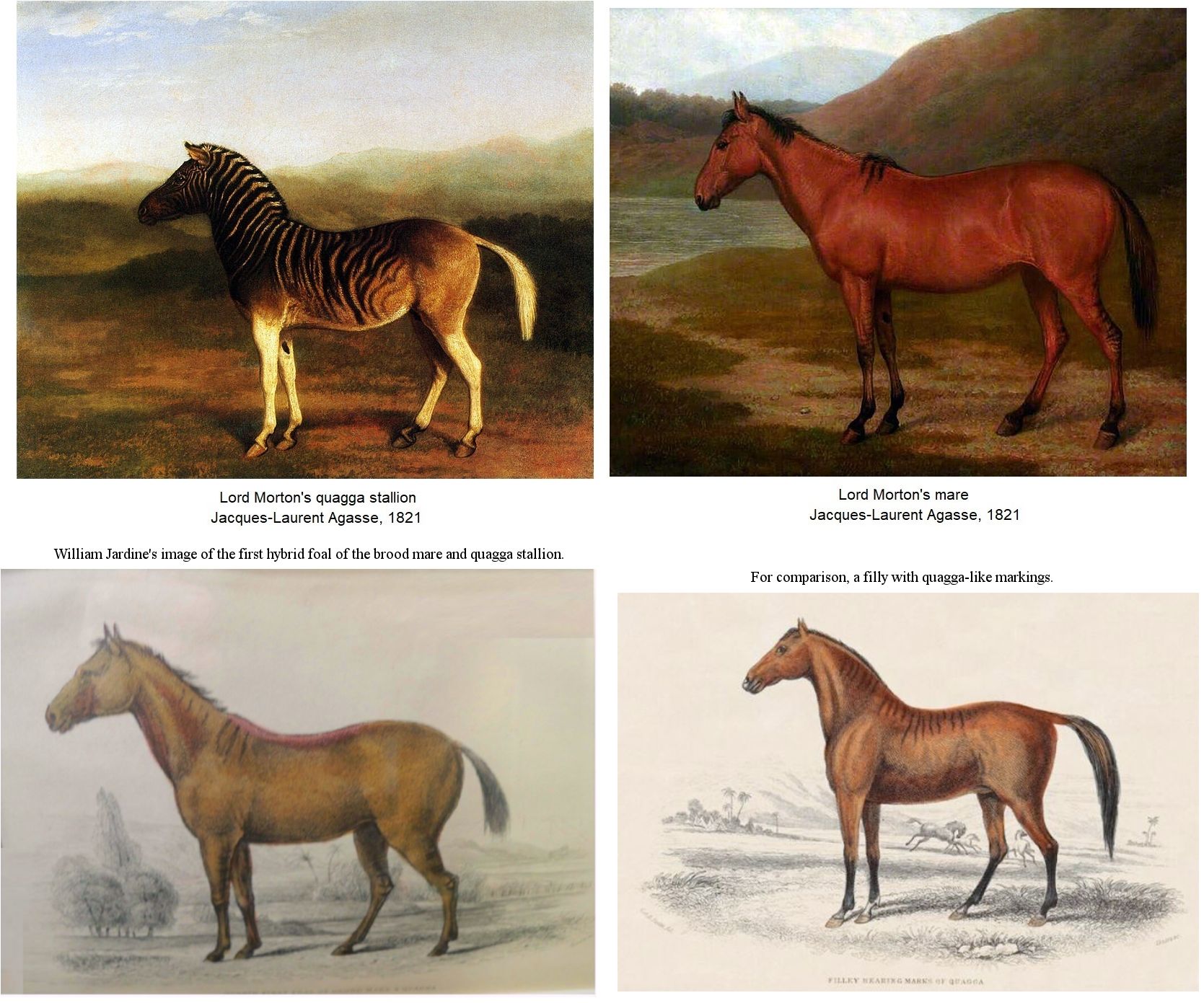
You are visitor number